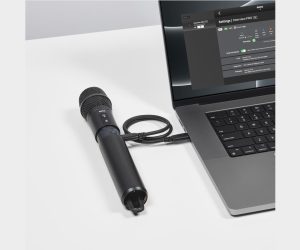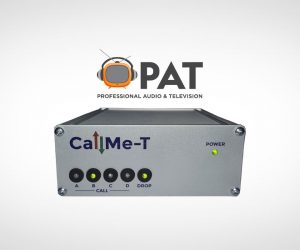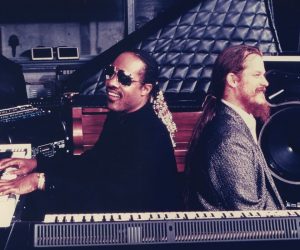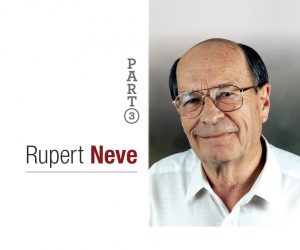
Interview with John Meyer, Part 2
Recently, Meyer Sound’s top tier descended on Sydney to celebrate its new alliance with Audio Brands. We sat down with the Meyers to talk about 12 year-olds on radio, the Grateful Dead’s Wall of Sound and chasing audio holograms. Here is the second instalment.
We haven’t been able to project sound forward, like a sound hologram. It’s starting to happen in video using lasers, but we haven’t got the equivalent with audio.
Everyone’s hoping we’ll figure out 3D sound… we’re hoping, too. It’s like the Greeks hoping to fly. I asked my mechanical engineer friends, “Could you build a hang glider out of materials that existed during Greek times or do you need high-tech materials to make a hang glider?”
They never figured out how to get a kite that wasn’t tethered to fly. They pulled people up with a string, so did the Tibetans, but no-one ever got a glider to work. Hang gliders seem fairly simple now. Why couldn’t they do it?
It’s how I feel about 3D sound; we know what we want to do — project sound so it sounds like someone’s next to you — it’s just that no experiments have worked so far. We’ve been working on that with UCLA for 20 years now and can get it to work a tiny little bit. We could be a thousand years away from this, or someone might discover it anytime.
To me, it’s like stumbling across Leonardo Da Vinci’s helicopter which is not clear enough in his picture to see how to build it. Was it even possible? Or, is it a fantasy in his head or a vision of the future?
When we do a Constellation system the best musicians and conductors agree it sounds like their concert hall. We know that technology, but we have to physically get rid of room sound, because we don’t have any good way of doing that electronically yet. We did an experiment for the movie industry in a lunch room next to a movie theatre. We tried to see if we could get rid of the low frequency sound that’s making it through the wall from the lunch room.
We had a copy of the movie track, so we didn’t have to pick it up with microphones. We started with one speaker and got a zone cancelled, then put another one over there to cancel that zone, but then the first one wasn’t working. After days the room was filled with speakers, and we were just starting to get one note. It’s cheaper to build a thicker wall.
We’re trying to make sure we’re not leaving anything out. Our quest has been to try and transfer as much information as we possibly can. Everyone asks if it’s overkill. Overkill is thinking, ‘Maybe we don’t have to do that much work.’ In the ’70s Kodak announced a million pixel CCD would be more resolution than we’d ever need! It was on the cover of a magazine. Really? We’re done? Now 4k is barely here and they’re already talking about 8k television.
People talk about overkill in the audio industry all the time… it’s ‘good enough’. People see how far they can compress the stuff until you don’t listen to it any more. At a certain point, where you won’t pay for it, they’ll back off a little step. It’s a race to the bottom, rather than FM, which was a race to the top.
We spent five years developing Leopard. We already had a line array so we decided to see if we could make it really hi-fi. It came from John [D.S.] Adams saying he was down at Disney Hall and didn’t like the sound of the speakers.
We needed to build something for classical people, because PA came from the ’20s, when they were just trying to announce and communicate; it wasn’t about a hi-fi experience. The industry has grown up from that perspective so trying to talk about hi-fi and PAs is like trying to talk about a hi-fi walkie-talkie. Everyone thinks you’re nuts.
We started on the Leopard project to see if we could build a hi-fi speaker that would be easy to use and have him start to integrate it into his music and playback.
In music they talk about how one note would have a different feel than this note. They live in a completely different world than we do from an engineering point of view. We’re trying to measure everything and build things to bridge the gap.
You can’t make Adams use anything, so it was super-exciting when he did.
Then we did the Blue Horn, another project where we were trying to make a speaker absolutely better. We tried a gas field where you charge up all the air so you have a million little needles and you run electricity through it to create ozone. Then you modulate the ozone, so it’s massless. But that has the same property as a regular loudspeaker so you haven’t gained anything. The problem isn’t mass — which everybody thought it was — it’s that low frequencies just don’t want to come out as quick as the high frequencies. For whatever reason, it just takes longer for them to form.
With computers it opens up the possibility that we could reconstruct it. We built the Blue Horn just to see if we could got rid of all the phase anomalies. It was a five-year project to do all of that, get the computer powerful enough to do trillions of calculations and have dynamic range at the end that’s over 120dB, so it’s quiet and doesn’t have any artefacts.
We’re like the gold miners from the 1800s who found a way of following porous quartz down to find the gold. They’d tunnel then stop, tunnel then stop, and slowly work their way. Today we need an atomic spectrometer to find porous quartz, it’s microscopic, but they figured out ways of doing that via exploration. That’s what we feel like, it’s the nature of exploration. We have enough tools to figure things out, but the tools get better as we play around.
















RESPONSES